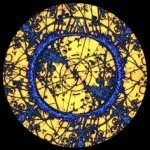
Each transition lens has millions of silver chloride particles. These particles only react when exposed to UV light hence transition lenses do not work when driving. Natural light or light through many windows does not contain light with UV wavelengths. When exposed to UV, the atoms oxidize and separate. The separated chlorine and oxygen then cluster together blocking some of the incoming light. This appears as darkening of lens.
This process then reverses, in the absence of UV light, but at a much slower rate than it occurred. Anyone who has walked from outside into a dark room wearing transitions only to find you can’t see anything with or without glasses knows what I mean. Well they turn back by a completely different process called thermal dependency which takes longer. The analogies I have seen compare the molecules to a pot of boiling water. Molecules which have more energy “open” at a faster rate clearing the lens. If the temperature is warmer the more molecules are left open than in colder weather. The result is that in the cold your lenses become darker and require more time to open and become clear once again. So to summarize, transition lenses rely on the physics of wavelengths of light and thermal dependence to make them an adjusting accessory.
So when you walk out school for summer vacation remembers that physics doesn't stop when you leave the classroom, it happens right before your very eyes.
As always thanks for reading! - ThePeculiarParticle
- Read more...
- 0 comments
- 2,069 views

